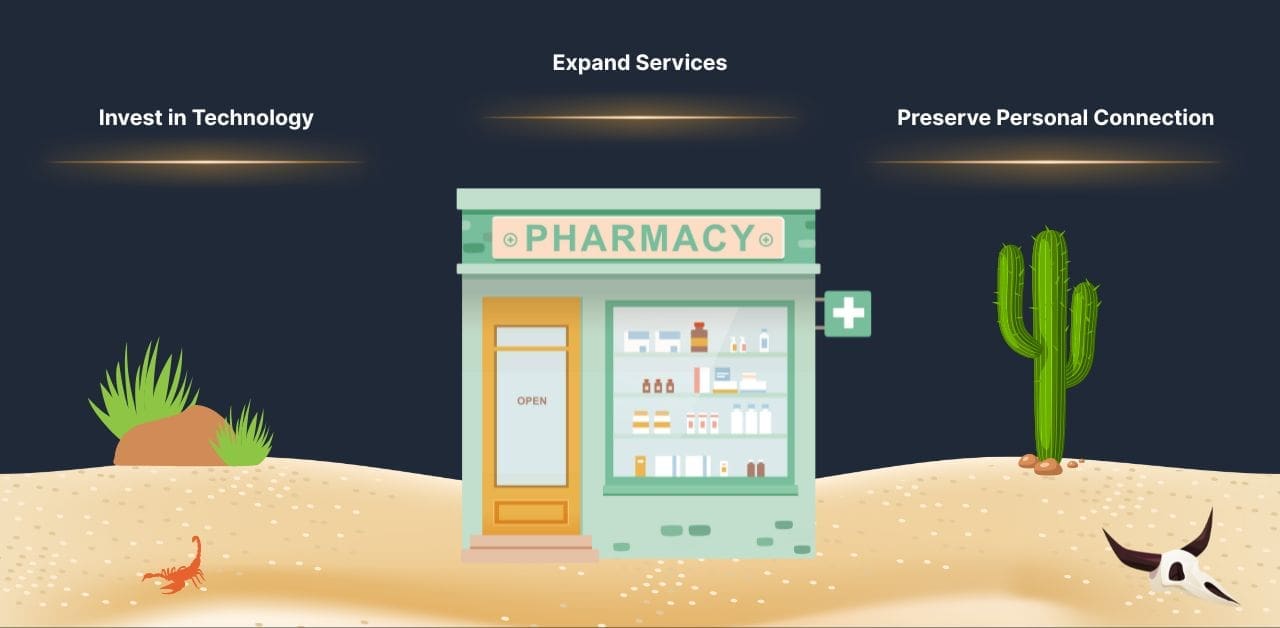The retail pharmacy landscape is vast but deeply interconnected. When a major shift affects one part of the industry, the ripple effects are often felt across the entire system. So when CVS, Rite Aid, and Walgreens announced plans to close thousands of stores nationwide, the impact extended far beyond their own operations. Independent pharmacies, many of which have served as trusted community staples for decades, are also being forced to shut their doors. These closures are contributing to the growing prevalence of pharmacy deserts.
Despite these challenges, today’s independent pharmacy owners and staff still have an opportunity not just to survive, but to thrive. In the sections that follow, we’ll explore how pharmacy deserts emerged, how they are reshaping the industry, and the strategic steps pharmacies can take to adapt. We’ll also show how C2 Keep is helping pharmacies navigate this changing environment. Those that act quickly and decisively will be best positioned for long-term success.
The Origins of Pharmacy Deserts
Although the term “pharmacy desert” has only recently gained mainstream attention, it has been in use for over a decade. According to Fred Gebhart from Drug Topics, the phrase was first introduced by Dima M. Qato in a 2014 Health Affairs article. It was inspired by the concept of “food deserts,” which describes areas where residents lack access to a nearby grocery store. Similarly, pharmacy deserts refer to communities with limited or no access to local pharmacy services, despite increasing demand.
Pharmacy Benefit Managers
A major contributor to pharmacy deserts is the unsustainable financial pressure placed on pharmacies by Pharmacy Benefit Managers (PBMs). As the Colorado Health Institute explains, PBMs act as intermediaries between drug manufacturers, insurance companies, wholesalers, consumers, and pharmacies. While they negotiate prices, they also set reimbursement rates, often so low that pharmacies struggle to break even. Over time, these losses force many locations to close, leading to an increase in pharmacy deserts.
The Impact of Closures
The consequences of widespread closures are significant. Rural and suburban communities alike have been affected, but the burden often falls most heavily on vulnerable populations. Neil Owens from Marley Drug notes that seniors, individuals with chronic conditions, and those with disabilities are especially impacted, as traveling farther to fill prescriptions can be difficult or even impossible.
Pharmacy staff are also feeling the effects. As more locations shut down, the job market becomes more competitive, making it harder for displaced professionals to find new opportunities.
How Pharmacy Deserts Are Reshaping the Future of Pharmacy
While pharmacy deserts have an obvious effect on the communities they touch, their influence also extends across the entire industry. When patients lose access to a local pharmacy, their needs do not disappear. They still need to manage chronic conditions, obtain prescriptions, and receive routine care. As a result, they are turning to alternatives, including traveling longer distances or using online pharmacy services.
Online Pharmacy Services
Online pharmacy services have grown rapidly since the COVID-19 pandemic began in 2020. With more brick-and-mortar pharmacies closing, digital platforms are gaining even more traction. According to Statista, approximately 68 million consumers purchased over-the-counter medications online in 2024, with that number projected to reach nearly 79 million by 2029. Major players such as Amazon Pharmacy, CVS, and Express Scripts now dominate the online space.
Overloaded Demand
At the same time, surviving pharmacies are facing a surge in demand as they absorb patients from nearby closures. This places added pressure on staff and operations. Pharmacists are expected to not only dispense medications but also deliver more personalized care and expanded clinical services. Unfortunately, many pharmacies lack the financial resources to hire additional help, forcing teams to do more with less.
Even with these obstacles, brick-and-mortar pharmacies still have the potential to grow. By embracing innovation and adapting to change, they can meet rising demand and help shape the future of pharmacy, especially in areas affected by pharmacy deserts.
Responding to the Industry Shift
One of the most important qualities modern pharmacies need is adaptability. While pharmacists have traditionally been cautious about change, the current pace of innovation requires a more proactive approach. Pharmacies that are thriving today are those expanding their services, embracing new technologies, and doubling down on the personalized care that sets them apart.
Expanding Services
Meeting consumer demand starts with convenience. Many patients want to address multiple health needs in a single visit, which is why services like medication synchronization (med sync) are gaining popularity. Med sync allows patients to pick up all of their prescriptions at once, improving adherence and streamlining care.
Pharmacists are also taking on more clinical responsibilities. As Kevin Diaz from RedSail Technologies explains, “Gone are the days when a flu shot or shingles vaccine are a niche commodity in your local pharmacy. Patients not only expect to get medications and vaccines, but so much more.”
Local delivery services are also expanding, offering fast and flexible solutions for patients who cannot easily visit a pharmacy in person. This includes those with limited mobility, chronic conditions, or compounded medication needs. As pharmacy deserts continue to grow, these services will be critical in maintaining access to care.
Invest in Technologies to Streamline Workflows
The challenges created by pharmacy deserts make operational efficiency more important than ever. Technology can help automate manual tasks, reduce errors, and allow pharmacists to focus more time on clinical services.
Controlled substance management, for example, is often time-consuming and high-risk. Pharmacies that invest in digital tools for this process can save hours each week while improving accuracy and compliance.
Pharmacy management systems are another area of opportunity. Kevin Minassian from Datascan emphasizes that “independent pharmacy owners need to start harnessing the technology within their pharmacy software systems. The best pharmacy management systems on the market offer automated features that, when utilized properly, can help you get more done with less staff.” When paired with cloud-based tools, these systems can significantly boost efficiency and better prepare pharmacies for the future of pharmacy.
Preserving the Personal Connection
Technology is essential, but so is maintaining the personal relationships that define independent pharmacy care. Unlike online providers, local pharmacies can offer real conversations, tailored recommendations, and a sense of trust that keeps patients coming back.
Patients visiting for vaccinations, consultations, or other services are more likely to fill their prescriptions on the spot. If they receive excellent care, they are less likely to switch to an online alternative that feels impersonal or inconvenient.
Over time, the ability to offer both personalized service and streamlined operations will separate thriving pharmacies from those that fall behind. As pharmacy deserts persist and healthcare needs grow, this balance will play a key role in shaping the future of pharmacy.
Final Thoughts
Pharmacists should view today’s industry changes as a chance to improve operations and plan for long-term success. Demand for pharmacy services will continue to rise, especially in communities affected by pharmacy deserts. These challenges are easier to navigate when pharmacists collaborate, share ideas, and support one another. Working together is essential to shaping the future of pharmacy and keeping care accessible to all.
Take the First Step With C2 Keep
C2 Keep is a fully-integrated, cloud-based solution that simplifies controlled substance compliance by replacing manual logbooks. Our platform helps pharmacies save time, reduce errors, and focus more on patient care. Today, we support over 1,500 pharmacists and staff committed to serving their communities with excellence.
Want to see how C2 Keep can support your pharmacy? Schedule a quick 30-minute demo with our founder and CEO, Roland Achenjang.

